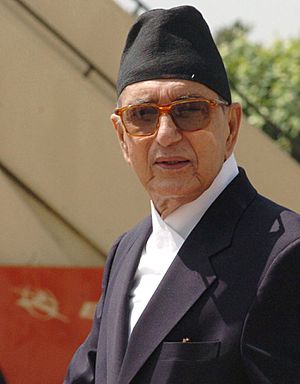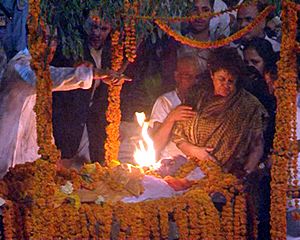Girija Prasad Koirala facts for kids
Quick facts for kids
Nepal Ratna
Girija Prasad Koirala
गिरिजाप्रसाद कोइराला |
|
|---|---|

Koirala in 2007
|
|
| Acting Head of State of Nepal | |
| In office 15 January 2007 – 23 July 2008 |
|
| Preceded by | Gyanendra (as King) |
| Succeeded by | Ram Baran Yadav (as President) |
| 30th Prime Minister of Nepal | |
| In office 25 April 2006 – 18 August 2008 |
|
| Monarch | Gyanendra |
| Deputy | Ram Chandra Poudel |
| Preceded by | Sher Bahadur Deuba |
| Succeeded by | Pushpa Kamal Dahal |
| In office 22 March 2000 – 26 July 2001 |
|
| Monarch | Birendra Dipendra Gyanendra |
| Preceded by | Krishna Prasad Bhattarai |
| Succeeded by | Sher Bahadur Deuba |
| In office 15 April 1998 – 31 May 1999 |
|
| Monarch | Birendra |
| Preceded by | Surya Bahadur Thapa |
| Succeeded by | Krishna Prasad Bhattarai |
| In office 26 May 1991 – 30 November 1994 |
|
| Monarch | Birendra |
| Preceded by | Krishna Prasad Bhattarai |
| Succeeded by | Man Mohan Adhikari |
| 5th President of Nepali Congress | |
| In office 11 January 1992 – 20 March 2010 |
|
| Preceded by | Krishna Prasad Bhattarai |
| Succeeded by | Sushil Koirala |
| Personal details | |
| Born | 4 July 1924 Saharsa, Bihar and Orissa Province, British India (present-day Bihar, India) |
| Died | 20 March 2010 (aged 85) Kathmandu, Nepal |
| Political party | Nepali Congress |
| Spouse | Sushma Koirala |
| Children | Sujata Koirala |
| Parent | Krishna Prasad Koirala (father) |
| Relatives | See Koirala family |
| Alma mater | Kirori Mal College (University of Delhi) |
Nepal Ratna Girija Prasad Koirala (Nepali: गिरिजाप्रसाद कोइराला ; 4 July 1924 – 20 March 2010) was an important Nepalese politician. People sometimes called him Girija Babu. He led the Nepali Congress political party. Koirala served as the Prime Minister of Nepal four times. These terms were from 1991 to 1994, 1998 to 1999, 2000 to 2001, and 2006 to 2008. He was also the Acting Head of State of Nepal from January 2007 to July 2008. This was a time when Nepal changed from a kingdom to a republic.
Koirala was active in politics for over sixty years. He helped start the first workers' movement in Nepal. This was called the Biratnagar jute mill strike in his hometown, Biratnagar. In 1991, he became the first democratically elected Prime Minister since 1959. His brother, B.P. Koirala, had also been Prime Minister after Nepal's first democratic election.
Contents
Early Life and Family
Girija Prasad Koirala was born in 1924 in Saharsa, Bihar, which was part of British India at the time. His family were Brahmins, a high caste in Nepal. His father, Krishna Prasad Koirala, lived in exile from Nepal.
In 1952, Koirala married Sushma Koirala. She was a headmistress at a women's school in Biratnagar. Their daughter, Sujata Koirala, was born in 1953. Sadly, Sushma died in an accident in 1967. Koirala and his daughter Sujata followed the Indian spiritual leader Sathya Sai Baba.
The Koirala family is very well-known in Nepalese politics. Two of Girija Prasad's brothers also became prime ministers. Matrika Prasad Koirala served from 1951 to 1952 and again from 1953 to 1955. Bisheshwar Prasad Koirala was Prime Minister from 1959 until King Mahendra took control in December 1960. Both Bisheshwar Prasad and Girija Prasad were arrested and sent to prison. After his release in 1967, Girija Prasad went to India with other leaders of the Nepali Congress Party (NCP). He did not return to Nepal until 1979.
Political Journey
Koirala started his political work in 1947. He led the Biratnagar jute mill strike, which was a major workers' protest. In 1948, he founded the Nepal Mazdoor Congress. This group later became known as the Nepal Trade Union Congress-Independent.
In 1952, he became the President of the Morang District Nepali Congress. He held this position until he was arrested. King Mahendra imprisoned him after a royal takeover in 1960. After being released in 1967, Koirala lived in India until 1979.
From 1975 to 1991, Koirala was the General Secretary of the Nepali Congress Party. He played a big part in the 1990 Jana Andolan. This was a movement that ended the Panchayat system of rule. It brought back multiparty politics to Nepal.
First Time as Prime Minister
In 1991, Nepal held its first multiparty democratic election. Koirala was elected as a member of parliament. His party, the Nepali Congress, won 110 out of 205 seats. He was then chosen as the leader of his party in parliament. King Birendra appointed him as Prime Minister.
During his first time in office, Koirala's government passed laws to make education, media, and health services more open. They also started Purbanchal University and the B.P. Koirala Institute of Health Sciences. These were in eastern Nepal. The government also allowed private companies to open medical and engineering colleges. They also built the B.P. Koirala Memorial Cancer Hospital with help from China.
In 1994, Koirala asked for new elections. This happened after some members of his own party voted against a government plan. This led to a new government led by the Communist Party of Nepal (Unified Marxist–Leninist).
Second Time as Prime Minister
Koirala became Prime Minister again in 1998. He took over from Surya Bahadur Thapa. First, Koirala led a government where his party had fewer seats. Later, he formed a government with two other parties. These were the Communist Party of Nepal (UML) and the Nepal Sadbhawana Party.
Third Time as Prime Minister

Koirala became Prime Minister for the third time in 2000. This happened after Krishna Prasad Bhattarai resigned. Nepal was fighting a civil war against the Communist Party of Nepal (Maoist) at this time. Koirala resigned in July 2001. After his resignation, the military was used in the civil war for the first time.
Fourth Time as Prime Minister
After the 2006 democracy movement, called the Loktantra Andolan, Nepal's parliament was brought back. On April 24, 2006, Koirala was chosen as Prime Minister again. He was selected by the leaders of the Seven Party Alliance. The parliament then passed laws to take away the King's powers. They also put the Army under the control of the government. Koirala became the temporary head of state of Nepal.
On April 1, 2007, Koirala was re-elected as Prime Minister. He led a new government that included the Maoist party. In May 2008, the Constituent Assembly voted to make Nepal a republic. This meant Nepal would no longer have a king. Koirala spoke to the assembly, saying Nepal was entering a "new era." He said that "the nation's dream has come true."
Fifth Time as Prime Minister
Girija Prasad Koirala continued as the Prime Minister of Nepal for a fifth term. After Nepal became a republic, there were talks about who would lead. The Nepali Congress wanted Koirala to be the first President of Nepal. However, the Maoist party, which had won the most seats, did not agree.
On June 26, 2008, Koirala announced he would resign. His resignation would become final after a new President was elected. Koirala was there when Ram Baran Yadav was sworn in as Nepal's first President on July 23, 2008. He then officially gave his resignation to President Yadav. Koirala congratulated Prachanda, the Maoist leader, when he was elected to take over as Prime Minister on August 15, 2008.
Later Years
Towards the end of his life, Koirala led a group of parties that supported democracy. They wanted to create a lasting democratic government in Nepal.
Koirala also wrote a book called Simple Convictions: My Struggle for Peace and Democracy.
Death

Girija Prasad Koirala passed away on March 20, 2010, at his daughter's home. He was 85 years old and had been suffering from asthma and lung disease. His funeral was held at Pashupatinath Temple in Kathmandu on March 21.
Many politicians shared their sadness when they heard of his death. The Hindu newspaper called him a "national guardian." Indian Prime Minister Manmohan Singh said Koirala was a "mass leader and a statesman." He added that Koirala's wisdom guided Nepal at important times. Ban Ki-moon, the Secretary-General of the United Nations, said Koirala "fought fearlessly" for justice and democracy. A senior Maoist politician, Baburam Bhattarai, said Koirala would be greatly missed.
Awards and Honors
In 2015, after his death, Girija Prasad Koirala was given the Nepal Ratna Man Padavi. This is the highest honor a Nepali citizen can receive from the Government of Nepal.
He also received the:
- Bangladesh :
- Bangladesh Liberation War Honour
See also
 In Spanish: Girija Prasad Koirala para niños
In Spanish: Girija Prasad Koirala para niños
- Biratnagar jute mill strike
- Bishweshwar Prasad Koirala
- List of prime ministers of Nepal


